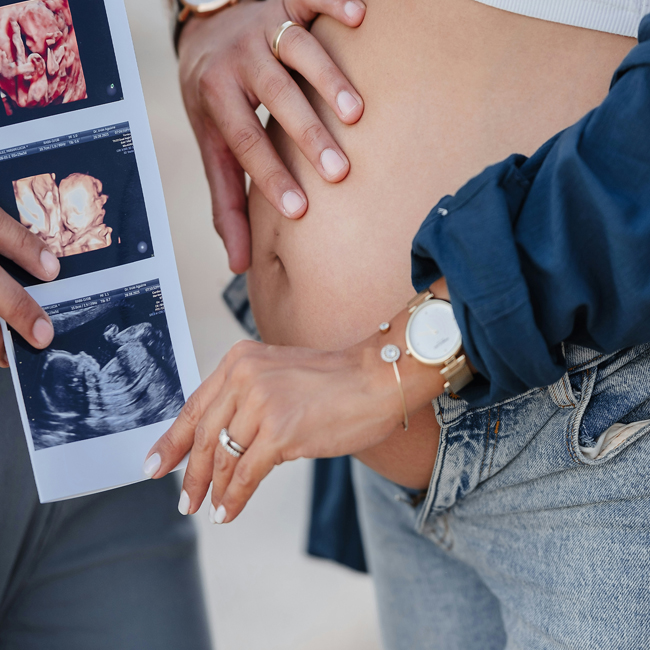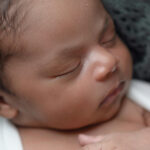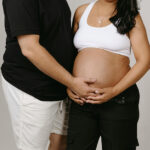Extremely low egg reserve with undetectable AMH < 1 pmol/L due to Fragile X Syndrome– A Story of Hope and Success
Patient Overview
- Patient: Mrs. F, 34 years old (G2P0)
- Partner: Mr. M, 39 years old
- History:
- Miscarriage (M/C) due to partial molar pregnancy in 2013.
- Second Pregnancy was affected by Fragile X syndrome, full mutation, which led to pregnancy termination at 16 weeks.
- Family history of Fragile X syndrome on the female side.
- Irregular shorter menstrual cycles ranging from 23-28 days.
- AMH: < 1 pmol/L, indicating diminished ovarian reserve.
- Semen Analysis: Normal.
- Previous failed IVF cycle at another IVF centre with no response.
Mrs. F and Mr. M faced tremendous emotional challenges, from a devastating miscarriage to discovering a genetic mutation that could be passed on to their children. Their family history of Fragile X syndrome compounded their concerns. Despite these setbacks, they persevered, seeking treatment at our centre to pursue their dream of having a healthy baby. The main challenge in treating this couple was that Mrs F had very few eggs, making it hard to collect enough for IVF. We also needed to create enough embryos so we could test them for Fragile X syndrome. For the testing to work, another hurdle is that the embryos needed to grow to an advanced stage called the blastocyst stage.
Treatment Path
- IVF Cycle 1 (19/11/2014)
- Long Down Regulation (LDR) protocol.
- 2 eggs retrieved, 2 fertilized, and 2 embryos tested.
- Result: Both embryos were affected by Fragile X syndrome, ruling them out for transfer.
- IVF Cycle 2 (13/02/2015)
- LDR protocol.
- 3 eggs retrieved, but unfortunately, no fertilization occurred.
- IVF Cycle 3 (06/04/2015)
- LDR protocol.
- 6 eggs retrieved, 4 fertilized, 1 embryo tested.
- Result: The tested embryo was unaffected (NAD).
- Outcome: The embryo was cryopreserved for future use.
- Frozen Embryo Transfer (27/05/2015)
- One thawed embryo transferred.
- Outcome: Biochemical pregnancy, indicating early pregnancy loss.
- IVF Cycle 4 (01/08/2015)
- LDR protocol.
- 6 eggs retrieved, 3 fertilized, 2 embryos tested.
- Result: One embryo unaffected (NAD), one affected by Fragile X syndrome.
- Outcome: The unaffected embryo was transferred in a later cycle.
- Frozen Embryo Transfer (19/09/2015)
- One thawed embryo transferred.
- Outcome: Successful live birth.
- IVF Cycle 5 (26/12/2016)
- LDR protocol.
- 2 eggs retrieved, 2 fertilized, both embryos tested.
- Result: Both embryos were unaffected (NAD) and cryopreserved.
- Frozen Embryo Transfer (20/02/2017)
- One thawed embryo transferred.
- Outcome: Another successful live birth.
Reflection
This case exemplifies the resilience of a couple determined to build a family, despite multiple genetic and fertility obstacles. Mrs. F’s diminished ovarian reserve (with an AMH level of less than 1 pmol/L) and family history of Fragile X syndrome presented significant challenges. Nonetheless, through tailored IVF treatment and genetic testing (PGT-M), we were able to identify healthy embryos and achieve two successful pregnancies, leading to live births in 2015 and 2017.
Conclusion
This case highlights the importance of personalized fertility treatment and the role of genetic testing in preventing hereditary conditions like Fragile X syndrome. Mrs. F and Mr. M’s journey from multiple IVF failures to the joy of parenthood is an inspiring testament to the possibilities of modern fertility care.










